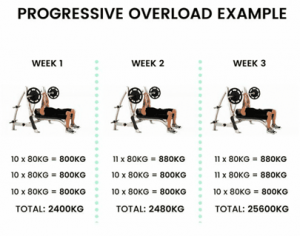Progressive overload is a crucial, fundamental part of training and is a vital driver of progress. Doing this one step well can take a lot of the guess work out of your training. Progressive overload is one of the main principles of training which also include: specificity, overload, progression, individualization, periodization, and reversibility.
Progressive overload means just that, it is the principle of slowly increasing the stimulus delivered to the body during each session to increase muscle size, strength, power, or endurance. It can be applied to any session, whether that be resistance training or cardiorespiratory training, through many different methods. For adaptation to occur, the specific tissue must be subject to higher-than-normal demands, without this, the body has no reason to undergo change. Depending on your training age (how long you have been training for) and style, the adaptations may be improvements in neuromuscular function, improvements in strength of the muscle or connective tissue, or increases in bone mass. Overload may also induce physiological changes including better use of the three energy systems: ATP-PC, lactic acid, and aerobic systems, and other physiological adaptations. Overload is not ‘shocking the body’ with crazy exercises, it is small steps each session to achieve whatever goal you set out to achieve.
How to incorporate progressive overload in your sessions:
- Overall volume- the volume you complete during your session, this total volume is a combination of total repetitions completed at a given load for each exercise. It can be progressed each time and it can be achieved with these variables:
- Sets- increased number of times you perform each exercise (e.g., From 3 to 4 sets)
- Repetitions- increase the number of repetitions for each exercise per set (e.g., From 8 to 10 repetitions)
- Load- increase the weight used (e.g., Go from using 10kg dumbbells to 12.5kg dumbbells)
- Time under tension- this is where you increase the time taken to perform each repetition, it may include pause repetitions or slow concentric (shortening) or eccentric (lengthening) phases, for example you may increase the eccentric portion (the way down) of your dumbbell bench press from 2 seconds to 4 seconds, doubling the time taken to complete the movement and the increasing contribution of the musculature
- Change your work to rest ratio- decrease your rest periods for the same amount of work so the body has slightly less time to recover after each set, therefore, increasing fatigue
- Increase training frequency- this may mean adding another training day into your week or it may simply mean training a specific muscle group more
Truthfully, it is not the fancy exercises you see all over social media that get you the results, it is doing the basics well and repeatedly. Using these methods in your training will provide variability to keep things interesting and will get help you achieve your goals effectively and within your desired time frame. If you need ideas on how to effectively use these in your training or if you need a program that you can progressively overload yourself, ask an Accredited Exercise Physiologist, Exercise Scientist, or Sport Scientist to help you devise a plan best suited to your goals.




